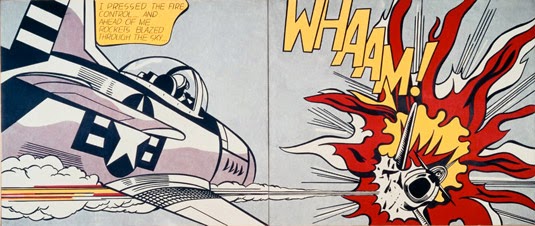Pop Art was born in Britain during the mid 1950,s. It was
the inspiration of a group of young rebellious artists - as most modern art tends
to be. The first appearance of the term Pop Art occurred during discussions
among artists who called themselves the Independent Group, which was part of
the Institute of Contemporary Art in London, begun around 1952-53. Towards the
late 1950s it started to emerge also in the United States of America.
The world of Pop Art tries to embrace what people want. It welcomes popular culture or sometimes also
referred to as “material culture”. It doesn’t
stand there and criticise the consequences of materialism and consumerism. It
just simply recognises its persistent presence as a natural occurrence. As a fact!
After the second world war, the youth of the time wanted to
express their optimism after so much hardship and privation buy creating a
youthful visual language. Colour was to be fundamental to all this. A means of brighten up what was a very dull
time in history. They turned to clever advertisements and building more on the
effective means of mass communication.
Which at the time consisted of films, TV, newspapers and magazines.
Pop art on the other hand, presented a challenge to
traditions of fine art. In pop art, recognisable material is sometimes visually
removed from its known context, isolated, and/or combined with unrelated
material. However, what wasn’t very well
understood by the previous generations was that the concept of pop art consisting
much to the art itself, but more as to the attitudes that led to it and later
on what it led.
Pop Art is commonly interpreted as a response to the
then-dominant ideas of abstract expressionism. Its use of objects and images have
similarities to Dada. Pop art is aimed to employ images of popular as opposed
to exclusive culture in art, emphasizing the banal or kitsch elements of any
given culture, most often through the use of irony. It also made use of mechanical means of
reproduction or rendering techniques of the time. Thus sometimes exaggerating
the pixilation’s and dots.
Key Characteristics
of Pop Art:
Familiar imagery, derived from popular media and products.
Flat imagery influenced by comic books and newspaper
photographs.
Usually very bright colours.
Images of celebrities or fictional characters in comic
books, advertisements and fan magazines.
Pop art frequently takes as its imagery that which is
currently in use in advertising. Product labelling and logos figure prominently
in the imagery chosen by pop artists, like in the Campbell's Soup Cans labels,
by Andy Warhol. Warhol also took this concept also to the shipping box
containing retail items like the Campbell’s Tomato Juice Box and also Brillo
Soap box sculptures.
Pop art made its way to being associated with the work of
New York artists of the early 1960s such as Andy Warhol, Roy Lichtenstein,
James Rosenquist, and Claes Oldenburg, (all heavy weights to this art) but
artists who drew on popular imagery were part of a world wide phenomenon in
various cities from the mid 1950s onwards.
By following in the footsteps and popularity of the Abstract
Expressionists, Pop's reintroduction of recognisable imagery was a major shift
for the direction of modernism. Pop artists celebrated everyday objects and
people in subject of that point in time. This was it seeked to promote popular
culture to the level of fine art. Perhaps owing to the incorporation of
commercial images, Pop art has become one of the most recognizable styles of
modern art.
Bibliography
ArtHistory.net.
(2013-2014 Bitter Soup LLC). ArtHistory.net. Retrieved January 25,
2015, from
http://arthistory.about.com/od/modernarthistory/a/Pop-Art-Art-History-101-Basics.htm
Foundation, J. W. (2015). Pop Art . Retrieved January
28, 2015, from The Art Story.org:
http://www.theartstory.org/movement-pop-art.htm
Wikipedia, t. f. (2015, January 15). Pop Art.
Retrieved January 2015, 25, from Wikimedia Foundation, Inc:
http://en.wikipedia.org/wiki/Pop_art














After all, this is what you were trained to do when you were in music school. By analyzing the music, you will be able to learn about how the sound has been formed. If you are curious to get more details about andy warhol, here you can get more information about it.
ReplyDelete